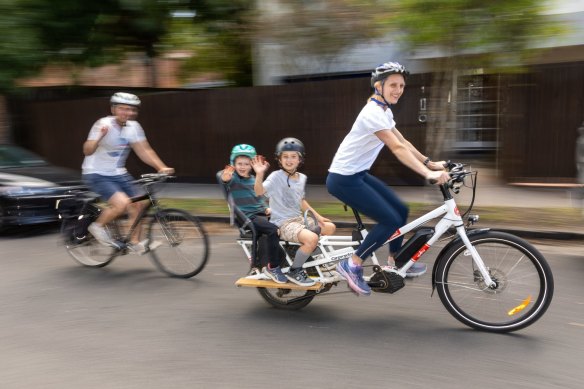This was published 1 year ago
Opinion
The EV revolution has stalled. Can these nifty bikes kick it back into gear?
Margot Saville
Deputy opinion editorRight now, our transition to electric cars is on pause. The true believers have already bought their EV, downloaded the charging apps and bored everyone senseless with the length of their “range”.
Those of us who would like that warm inner glow, but can’t afford to spend $61,900 on a new Model 3 Tesla, are waiting for prices to come down and the number of highway chargers to go up. US economist David Rapson says the EV revolution has arrived at the end of its first era. The next phase, when they go from early to mass adoption, depends on “the pragmatists”, who will buy whatever car seems the best and are waiting for issues around price, range and charging to be sorted out.

Melbourne mum Susan Oryzak and her family don’t own a car.Credit: Jason South
In the meantime, potential buyers are sitting on their hands. Last week Tesla, the largest manufacturer of EVs, reported quarterly sales well below the Wall Street forecast, 20 per cent lower than its December-quarter sales, and 8.5 per cent lower than the same period last year.
It’s not just the executives at Tesla who are scratching their heads. Anecdotally, the number of people who actually drive a car is falling – fewer 17-year-olds have a driver’s licence, compared with almost 100 per cent just two generations ago. My 27-year-old daughter, who lives just a few minutes walk from a train station and two bus routes in Sydney’s inner west, plans to do her driving test in the next month. But she doesn’t own a car and has no plans to get one. After shopping at the local markets, there are rental e-bikes to help her carry it home.
In fact, she lives close to the T3 heavy rail line, which is about to close down for 12 months between Sydenham and Bankstown for conversion to a metro. As reported by the Herald’s city editor, Michael Koziol, the passengers will be offered the use of an e-scooter to get to alternative stations.
Many people have been weighing up the costs and charging issues around EVs and have come to the conclusion that it’s easier to own an e-bike. Certainly, once someone buys an e-bike and uses it regularly, they don’t look back. Construction executive Katya Crema and her family live in South Melbourne; she and her partner would rather transport their two small children to and from daycare and on outings on one of their two e-bikes than use the family Tesla. Riding the bikes is “much more enjoyable than being stuck in peak-hour traffic”, she told me.
The vast majority of us travel by car because we already own a car – it’s a habit. Most Australians live in metropolitan areas, where 50 per cent of all trips – by car, train, bus or “active transport” (bikes and walking etc) are less than five kilometres. In addition, post-lockdown, many of us work from home at least some of the week. I don’t have off-street parking and my car can spend days marooned outside the house, gaining a thick covering of dust and blossoms.
But I’m just as lazy as the next person. The Balmain shops are only two kilometres down the road and if I need a walk and some supplies, it’s a pleasant 30-minute stroll. Truthfully, however, I usually jump in the car. But now that I don’t have children who need ferrying around, there’s no reason for me to do that trip in a carbon-emitting vehicle. And if the weather is bad, isn’t that what delivery apps are for?
It seems that everyone who lives in cities is presently weighing up the arguments about whether to drive. European and US car sales peaked in 2019. About 5.5 million e-bikes were sold in the EU in 2022, compared with 2 million electric cars. In Australia, sales of e-bikes grew from 9000 in 2017 to more than 100,000 in 2022, according to Bicycle Industries Australia. Worldwide, according to Bloomberg, there are 280 million electric mopeds, scooters, motorcycles and three-wheelers compared with only 20 million passenger EVs.
I own a very small and inexpensive Kia Picanto – referred to by my friends as “the sewing machine on wheels”. But if I had any sense, I’d sell the car, which costs me about $150 a week in petrol, insurance, registration and servicing, and buy an e-bike. This would set me back about $1000 to $5000; a full battery charge of an e-bike costs 10–15 cents, giving you a range of 50 to 100 kilometres. The money I saved would pay for a lot of taxis and Ubers. And if I rode it enough, I could even drop my gym membership.
The bragging rights and feeling of smug moral superiority, of course, are totally free. But the biggest advantage of all? You can jump on an e-bike without donning a single piece of lycra. Sign me up.
Margot Saville is The Sydney Morning Herald’s deputy letters editor and the author of The Teal Revolution.